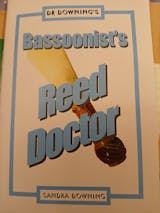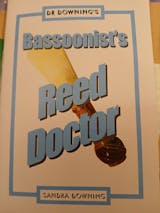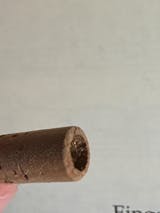For a bassoon reed to work at it's best (vibrate at its optimum level) it needs the be correctly balanced. This means that the reed should have the same thickness of cane on both front and back blades and on each half of both blades (see diagram below).

If you are having a problem with your reed(s) the first step should be to check that it is correctly balanced as this quite often will solve the main problems with the reed.
Below are 2 methods to use to check if the reed is balanced and if it is not, find where the issue is and correct it. For all of the tests you will need a very sharp reed making knife or diamond coated file to correct the issues.
The following tests involve cane being removed from the reed. Therefore it is important to note that once you have removed the cane you can not put it back, thus only take a little cane off at a time!
Bubble Test
In this test you are aiming to have the opening at the tip of the bassoon reed, the 'bubble', symmetrical at all times. Place your index finger on one side of the bassoon reed and your thumb on the other so that they are both in the center back of the blade (so that if the bassoon reed wasn't there your thumb and index finger would be touching). Now gently press the fingers towards each other so that the reed starts to close at the tip (Try to keep the pressure of your finger and thumb equal).
Ideally, when you are applying pressure to both sides the bubble at the tip of the bassoon reed will close equally on both sides so that when quite a lot of pressure is used both blades at the tip will touch at the same time. If they do, you need not do any more to that part of the bassoon reed.

If the reed doesn't close symmetrically then note the side of the blade where the tip has the larger asymmetrical opening. Then go directly towards the back of the reed until you are in line with your finger and remove a small amount of cane from this area. Then redo the test with your finger and thumb in the same place and remove more cane if necessary until the reed begins to close more symmetrically and is thus more balanced.
Repeat the whole process, each time moving your finger and thumb closer to the tip of the bassoon reed and then start at the back of the reed again but on the side of the reed and work forward again until your fingers have touched every area if the bassoon reed blade.
Side 'Burns' (Blades) Test
This test uses a bassoon plaque & is very simple to carry out.

Place the plaque in between the blades of the bassoon reed and then pull the plaque gently to one side of the reed so that you can see the longer edge of the plaque (diagram, right). Once you have done this you will be able to compare the edges of the blades of the reed. If one area is thicker than it is on the blade directly opposite from it, use the reed making knife or diamond file to remove cane from the thicker side. Once the one side has been checked pull the plaque to the other side and repeat the same process.
Read our in depth bassoon reed here: How to Adjust Bassoon Reeds
I hope you found this guide useful, if you know of any other ways to test if a reed is correctly balanced please do let us know!
This Article Was Written / Collated By
|
|
Bassoonist at Crook and Staple |




